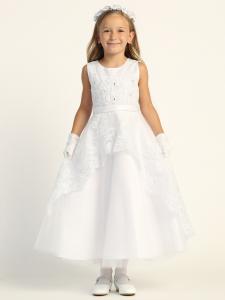
Malcolm Royce Publishes Comprehensive Article on the History and Symbolism of White Communion Dresses
This in-depth piece offers a thorough exploration of First Communion dresses, tracing their origins from early Christian practices to modern-day interpretations
NEW YORK, NY, UNITED STATES, September 27, 2024 /EINPresswire.com/ -- Historical Origins: The piece traces the roots of white communion dresses back to early Christian baptismal traditions, explaining how the practice evolved as First Communion became a separate ceremony from baptism. The article explores the shift from adult baptisms in the early church to infant baptism and the subsequent emergence of First Communion as a distinct rite of passage. It details how the white garments worn for baptism in the early church symbolized spiritual cleansing and new life in Christ, a symbolism that carried over to communion dresses.Symbolic Significance: Readers will gain insight into the profound symbolism of white in Christian contexts, representing purity, innocence, and new beginnings. The article explores how this symbolism is embodied in communion dresses. It delves into Biblical references to white garments and their spiritual significance, connecting these to the tradition of white communion dresses. The piece also discusses how the dress serves as a visual reminder of baptismal promises and the child's commitment to faith.
Style Evolution: The article chronicles the transformation of communion dress styles from simple, baptismal-like garments to the more elaborate Victorian-era designs, and finally to modern interpretations that balance tradition with contemporary fashion. It provides a decade-by-decade analysis of changing styles, noting influences from broader fashion trends and societal shifts. The piece includes descriptions of typical dress features from different eras, such as the introduction of lace, veils, and specific silhouettes.
Cultural Diversity: Highlighting the global nature of this tradition, the piece examines cultural variations in communion dress customs across different countries and denominations. It explores how different cultures have adapted the tradition, from the ornate styles popular in Spain and Latin America to the more understated approaches in some Northern European countries. The article also touches on how Eastern Orthodox traditions incorporate elements like crowns or wreaths with the dresses.
Family Traditions: The practice of preserving communion dresses as cherished family heirlooms is explored, emphasizing the emotional and spiritual significance of passing these garments through generations. The article includes anecdotes from families who have maintained this tradition, discussing how dresses are altered or embellished for each new wearer, adding to their unique history.
Societal Reflections: The article discusses how changing societal norms have influenced communion dress trends, from the "mini-bride" looks of the mid-20th century to more age-appropriate styles today. It examines how these changes reflect broader shifts in attitudes towards children's clothing and religious ceremonies. The piece also explores the debate surrounding the appropriateness of certain styles and how different communities have addressed these concerns.
Modern Considerations: Contemporary issues such as sustainability, ethical production, and alternative styles are addressed, reflecting current concerns in fashion and consumerism. The article discusses the growing trend of eco-friendly and ethically produced communion dresses, including options made from organic or recycled materials. It also explores alternative styles for girls who may not feel comfortable in traditional dresses, such as white pantsuits or culturally specific attire.
Care and Preservation: Practical advice on maintaining and preserving communion dresses is provided, along with creative ideas for repurposing these cherished garments. The article offers step-by-step guidelines for cleaning and storing dresses to maintain their quality over time. It also suggests innovative ways to give dresses a second life, such as transforming them into christening gowns, decorative pillows, or framed textile art.
"This comprehensive article represents our commitment to exploring the deep-rooted traditions that continue to shape modern religious practices," said M.S, at Malcolm Royce. "By examining the history and symbolism of communion dresses, we offer readers a unique perspective on how fashion intersects with faith and cultural identity."
The timing of this publication is particularly relevant as families worldwide prepare for upcoming First Communion ceremonies and shopping season for 2025 events, typically held in the spring. The article serves as an invaluable resource for parents, providing both historical context and practical considerations for this significant milestone.
"Our goal was to create a definitive guide that not only informs but also celebrates the rich tapestry of traditions surrounding girls at First Communion," M.S added. "We believe this article will resonate with families, religious leaders, and anyone interested in the interplay between fashion and spiritual practices."
M.S
Malcolm Royce
email us here
Visit us on social media:
Facebook
X
Instagram
Distribution channels: Conferences & Trade Fairs, Consumer Goods, Culture, Society & Lifestyle, Religion, Retail
Legal Disclaimer:
EIN Presswire provides this news content "as is" without warranty of any kind. We do not accept any responsibility or liability for the accuracy, content, images, videos, licenses, completeness, legality, or reliability of the information contained in this article. If you have any complaints or copyright issues related to this article, kindly contact the author above.
Submit your press release

